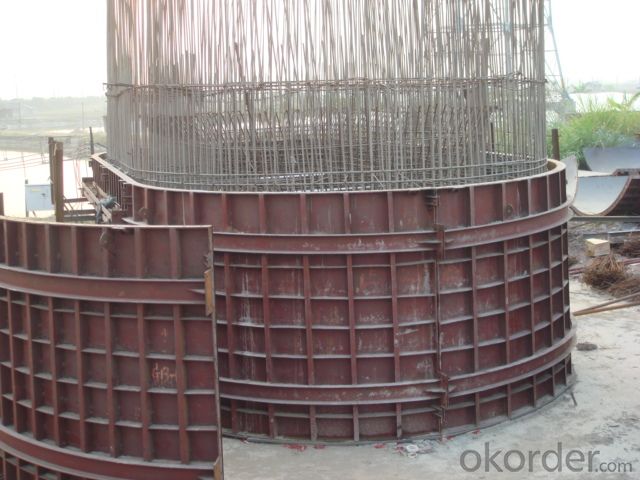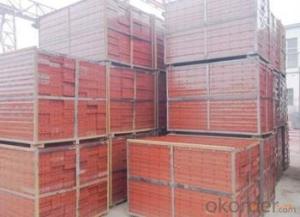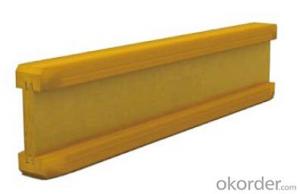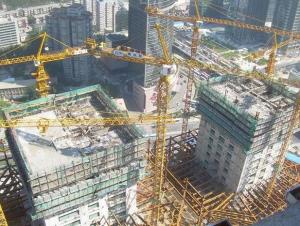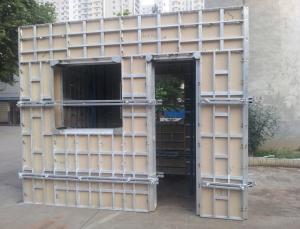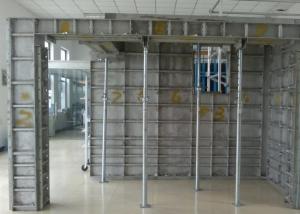Form work
- Loading Port:
- China Main Port
- Payment Terms:
- TT OR LC
- Min Order Qty:
- -
- Supply Capability:
- -
OKorder Service Pledge
OKorder Financial Service
You Might Also Like
Specifications
Steel Formwork, Available in Various Weights, Dimensions and Area, Suitable for DocksSteel formwork
Were engaged in development and manufacturing of the special type steel formwork for highways, railways, bridges, tunnels, walls, docks, reservoirs, large-scale stadiums, exhibition centers, and more
Specifications:
Dimension: 300 x 1,500 x 55, 300 x 1,200 x 55, 300 x 900 x 55, 300 x 600 x 55, 250 x 1,500 x 55, 250 x 1,200 x 55, 250 x 900 x 55, 250 x 600 x 55, 100 x 100 x 1,500, 100 x 100 x 1,200, 100 x 100 x 900, and 100 x 100 x 600mm
Area/pc:0.45, 0.36, 0.27, 0.18, 0.375, 0.30, 0.225, 0.15, 0.30, 0.24, 0.18, and 0.12m2
Weight: 17.99, 14.98, 11.86, 8.68, 15.60, 13.80, 10.46, 7.87, 15.40, 12.86, 10.86, and 7.48kg
Other dimensions and shapes are subject to mutual discussions


- Q: How long does steel formwork last?
- The lifespan of steel formwork can vary depending on various factors such as the quality of the steel used, the type and frequency of usage, and the maintenance practices employed. Generally, steel formwork is known for its durability and longevity, and when properly maintained, it can last for several years or even decades. With regular maintenance and proper handling, steel formwork can withstand multiple uses and continue to perform effectively. However, it is important to note that steel formwork may experience wear and tear over time due to the constant exposure to concrete, which can lead to surface corrosion or deterioration. This can be mitigated by applying protective coatings or cleaning the formwork after each use. Furthermore, the lifespan of steel formwork can also be influenced by external factors such as environmental conditions and the type of concrete being poured. Harsh weather conditions or exposure to chemicals can accelerate the corrosion process, potentially reducing the lifespan of the formwork. To ensure the longevity of steel formwork, it is important to invest in high-quality steel with proper anti-corrosion properties, carry out regular inspections, and perform necessary maintenance and repairs when needed. By following these practices, steel formwork can last for a considerable amount of time, making it a cost-effective and reliable option for construction projects.
- Q: How does steel formwork impact the overall sustainability of a project?
- The overall sustainability of a project can be significantly influenced by the use of steel formwork. Firstly, steel is an incredibly durable material that can withstand repeated use, allowing the formwork to be reused multiple times before reaching the end of its life cycle. This reusability reduces the need for frequent replacements, thereby minimizing material consumption and waste generation during construction. Furthermore, steel formwork is renowned for its strength and structural stability, enabling the construction of robust and long-lasting structures. This means that buildings constructed with steel formwork are more likely to have a longer lifespan, reducing the necessity for frequent renovations or demolitions. As a result, this leads to a decrease in resource consumption and the associated carbon emissions that accompany new construction. Additionally, steel is a highly recyclable material, and steel formwork can be easily recycled at the end of its life cycle. The recycling process of steel requires less energy compared to the production of new steel, thereby reducing the project's carbon footprint. By choosing steel formwork, construction projects can contribute to the circular economy by promoting the use of recycled materials and diminishing landfill waste. Moreover, steel formwork offers improved efficiency in construction processes. Its modular nature and ease of assembly make it a time-saving option, reducing construction time and, consequently, the energy consumption required for on-site operations. The expedited construction process also minimizes disruption to the surrounding environment, lessening the overall environmental impact of the project. Lastly, steel formwork can enhance the overall sustainability of a project by providing a safer working environment for construction workers. Its strength and stability ensure that the formwork remains secure during concrete pouring, reducing the risk of accidents and injuries. This promotes the well-being of workers and aligns with the principles of social sustainability. In conclusion, the use of steel formwork has a positive impact on the overall sustainability of a project. Its durability, reusability, and recyclability contribute to resource conservation, reduction in carbon emissions, and long-term viability of structures. By opting for steel formwork, construction projects can advance sustainability objectives and contribute to a more environmentally and socially responsible built environment.
- Q: Are there any specific quality control measures for steel formwork installation?
- Yes, steel formwork installation has specific quality control measures in place to guarantee correct installation and adherence to required standards. Before installation, one key quality control measure involves inspecting the steel formwork for damages, defects, or deviations from specifications. Any issues discovered during the inspection must be addressed and resolved before proceeding with installation. Verifying the dimensions and alignment of the steel formwork is another quality control measure. This ensures that the formwork is fabricated accurately and aligned properly with the structure. Inaccurate dimensions or misalignment can cause issues during concrete pouring and impact the final structure's quality. Furthermore, quality control measures include checking the stability and strength of the steel formwork. This involves confirming that the formwork is adequately braced and supported to withstand the concrete's pressure. It's crucial to ensure that the formwork can bear the load without deforming or failing. Moreover, closely monitoring the installation process itself is essential to ensure compliance with required procedures and standards. This includes verifying that the formwork is securely fastened and all connections are properly made. Any deviations from installation procedures should be promptly addressed and corrected. Regular inspections and audits should be conducted throughout the installation process to track progress and identify potential issues. This allows for timely interventions and corrections, ensuring that the steel formwork installation meets required quality standards. In conclusion, specific quality control measures are crucial for steel formwork installation to ensure the structure's integrity and safety. By implementing these measures, potential issues or defects can be identified and resolved early on, minimizing the risk of expensive rework or structural failures.
- Q: What are the different types of formwork connectors used in steel formwork?
- There are several types of formwork connectors that are commonly used in steel formwork systems. These connectors play a crucial role in ensuring the stability and strength of the formwork structure. Some of the different types of formwork connectors used in steel formwork include: 1. Wedge Lock Connector: This type of connector is widely used in steel formwork systems. It consists of two separate pieces – a wedge and a lock. The wedge is inserted into the formwork joint, and the lock is then inserted to secure the wedge in place. This connector provides a tight and secure connection, which helps in maintaining the formwork's stability. 2. Pin and Wedge Connector: This connector comprises a pin and a wedge. The pin is inserted through the holes in the formwork panels, and the wedge is then driven into the hole, securing the pin in place. The pin and wedge connector is easy to install and provides a strong connection between the formwork panels. 3. Rapid Clamp Connector: This type of connector is designed to quickly and securely connect steel formwork panels. It consists of a clamp that is tightened around the formwork panel, providing a reliable and sturdy connection. The rapid clamp connector is often used in applications where a quick assembly and disassembly of formwork is required. 4. Hook and Loop Connector: This connector utilizes a hook and loop fastening system to connect the formwork panels. The hook and loop strips are attached to the edges of the formwork panels, allowing them to be easily and firmly connected. This type of connector is commonly used in applications where frequent adjustments or reconfigurations of the formwork are needed. 5. Magnetic Connector: This connector uses magnets to securely connect the steel formwork panels. The magnets are embedded within the formwork panels, allowing them to easily snap together. The magnetic connector is known for its quick installation and disassembly, making it ideal for projects with tight schedules. These are just a few examples of the different types of formwork connectors used in steel formwork. Each connector has its own unique features and benefits, and the selection of the appropriate connector depends on the specific requirements of the project and the formwork system being used.
- Q: Can steel formwork be used for soundproofing walls?
- Steel formwork is primarily used for creating the structure and shape of concrete walls during construction. While steel formwork is sturdy and durable, it is not specifically designed for soundproofing purposes. Soundproofing walls typically require materials with high acoustic performance and insulation properties to effectively block or absorb sound waves. While steel formwork may offer some level of sound reduction due to its density, it is not sufficient for achieving significant soundproofing results. To effectively soundproof walls, it is recommended to use specialized materials such as acoustic insulation, mass-loaded vinyl, or soundproof drywall, which are designed specifically for this purpose.
- Q: Are there any weight restrictions for transporting steel formwork?
- Weight restrictions for transporting steel formwork are usually in place. The exact weight limitations can differ based on the mode of transportation, like trucks, cranes, or forklifts. Adhering to these restrictions is essential for the safety of the transport and to avoid any harm to the formwork or vehicle. Moreover, going over the weight limits can lead to legal repercussions, including fines or penalties. Hence, it is vital to refer to the appropriate transportation guidelines and regulations to ascertain the specific weight restrictions for transporting steel formwork.
- Q: How does steel formwork contribute to the fire resistance of the structure?
- Steel formwork, also known as steel molds or frames, significantly contributes to the fire resistance of a structure in several ways. First and foremost, steel is an inherently fire-resistant material. It has a high melting point and does not combust easily, making it an ideal choice for formwork in fire-prone areas. When steel formwork is used in construction, it provides a strong and rigid structure that helps maintain the integrity of the building during a fire. The steel molds hold the concrete in place, preventing it from collapsing or disintegrating when exposed to high temperatures. This structural stability allows firefighters to safely enter the building and extinguish the fire without the fear of sudden structural failure. Moreover, steel formwork can act as a heat sink during a fire. The high thermal conductivity of steel allows it to absorb and dissipate heat quickly, minimizing the spread of fire and reducing the overall temperature within the structure. By absorbing heat, steel formwork helps delay the point at which the concrete begins to spall or crack, thereby maintaining the structural integrity of the building for a longer period. Additionally, steel formwork is often designed with appropriate fire-resistant coatings or insulation materials. These coatings provide an extra layer of protection against the heat, flames, and smoke generated during a fire. They can also help in preventing or slowing down the transfer of heat to the concrete, further enhancing the fire resistance of the structure. Overall, the use of steel formwork in construction significantly contributes to the fire resistance of a building by providing structural stability, acting as a heat sink, and incorporating fire-resistant coatings or insulation materials. By utilizing steel molds, architects and engineers can ensure the safety and durability of the structure, even in the event of a fire.
- Q: Can steel formwork be used for both residential and industrial construction projects?
- Yes, steel formwork can be used for both residential and industrial construction projects. Steel formwork is highly versatile and can withstand heavy loads, making it suitable for various construction applications. Its durability and strength make it ideal for use in both residential and industrial settings.
- Q: Can steel formwork be used for both vertical and inclined concrete placements?
- Yes, steel formwork can be used for both vertical and inclined concrete placements. Steel formwork is known for its durability and flexibility, making it suitable for various types of concrete placements, including both vertical and inclined surfaces. It provides the necessary structural support and ensures a smooth finish for the concrete, making it a preferred choice for construction projects requiring different angles and inclinations.
- Q: What are the common safety training requirements for steel formwork installation?
- The common safety training requirements for steel formwork installation involve several key aspects to ensure the safety of workers and the successful completion of the project. These requirements may vary depending on the specific regulations and standards set by the local authorities and the company's policies. However, some of the common safety training requirements for steel formwork installation include: 1. General Construction Safety Training: All workers involved in steel formwork installation should receive general construction safety training, which covers topics such as hazard identification, personal protective equipment (PPE) usage, emergency procedures, and safe work practices. This training ensures that workers have a basic understanding of construction site safety. 2. Fall Protection Training: Given that steel formwork installation often involves working at heights, fall protection training is crucial. Workers should be trained on the proper use and inspection of fall protection equipment, such as harnesses, lanyards, and anchor points. They should also learn how to set up and dismantle temporary fall protection systems like guardrails and safety nets. 3. Material Handling and Lifting Training: Steel formwork components can be heavy and require proper lifting techniques to avoid injuries. Workers should receive training in safe lifting practices, including correct body mechanics, proper use of lifting equipment such as cranes or forklifts, and understanding load capacities. 4. Scaffold Safety Training: Steel formwork installation often involves the use of scaffolding to access higher areas. Workers should be trained on safe scaffold erection, inspection, and usage. This includes knowledge of scaffold components, stability, fall protection on scaffolds, and safe practices for working on scaffolds. 5. Electrical Safety Training: Steel formwork installation may involve working near electrical systems or equipment. Workers should receive training on electrical safety, including identifying electrical hazards, using lockout/tagout procedures, and understanding safe distances from power lines. 6. Hazard Communication Training: Workers should undergo training on hazard communication protocols, including the identification and understanding of safety data sheets (SDS) and proper handling of hazardous materials commonly used in steel formwork installation. 7. First Aid and CPR Training: In the event of an accident or injury on the job site, workers should be trained in basic first aid and cardiopulmonary resuscitation (CPR) techniques. This training can help stabilize an injured worker until professional medical help arrives. It is important for employers to ensure that all workers receive comprehensive safety training before commencing steel formwork installation. Regular refresher courses and ongoing safety awareness programs should also be conducted to reinforce safe work practices and maintain a high level of safety on the job site.
Send your message to us
Form work
- Loading Port:
- China Main Port
- Payment Terms:
- TT OR LC
- Min Order Qty:
- -
- Supply Capability:
- -
OKorder Service Pledge
OKorder Financial Service
Similar products
Hot products
Hot Searches
Related keywords

